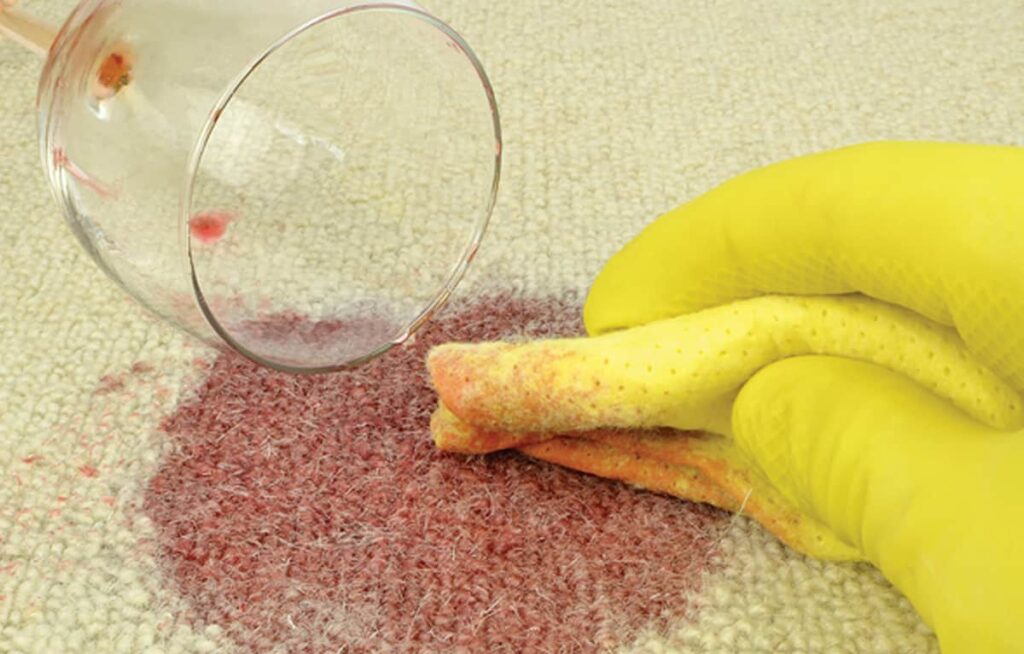How do you remove those pesky stains? Sometimes, even after you’ve used kitchen towels, rugs, all manner of detergents, baking soda, tips from mom, etc. the stubborn stain is still right there staring at you in the face! Worse still, even after you’ve called your ‘professional carpet cleaners’ and paid good money, the stain is not completely gone.
What do you do?
Let’s take it step by step.
DIY Carpet Stain Removal
To lessen the possibility of staining, immediate action should be taken when any spillage or accident occurs. Blot up all liquid or scrape up as much of the spilled substance as possible. Then, put a thick layer (1/2” – 1”, 1-2cm) of clean, white absorbent material or toweling over the area and weigh down with a large book or suitable weight. Replace the absorbent material often in order to absorb as much of the spill as possible until no more stain removal is evident.
Related Post: How to Look After your Carpets with Care
If It Doesn’t Work, Call Your Carpet Cleaning Specialist
Call your local Carpet Cleaning Specialists to learn how to safety treat the area before it becomes a permanent stain. However, there is a huge difference between carpet cleaning specialists. There are those who use generic cleaning agents with no accreditation from international bodies, and sometimes they can clean up the less complicated spills.
However, when it comes to more stubborn stains, they hold up their hands and surrender. The skilled professional technicians who are affiliated with international bodies like the Institute of Inspection Cleaning and Restoration Certification, Restoration Industry Association and Carpet and Rug Institute can give you the best cleaning and stain care for your carpets possible. Big Red is proud to be one of the few companies in Singapore accredited by all 3. We use the best methods of carpet cleaning to ensure that all of our services are top-notch.
An additional service offered by some carpet cleaners is spot dyeing of discolored areas. This may provide a closer color match to the surrounding, unstained areas, but is only possible on some textiles. Stronger stain removal treatments may also be possible but with these come the added risk of further color change or color loss. Many cleaners avoid these specialty procedures because of the difficulties and risks involved. Some cleaners will undertake these measures in selected cases, with the permission and signed damage release from the customer, for an additional service charge.
Related Post: Why Hiring Cheap Carpet Cleaning May be a Mistake
An additional service offered by some cleaners is spot dyeing of discolored areas. This may provide a closer color match to the surrounding, unstained areas, but is only possible on some textiles. Stronger stain removal treatments may also be possible but with these comes the added risk of further color change or color loss. Many cleaners avoid these specialty procedures because of the difficulties and risks involved. Some cleaners will undertake these measures in selected cases, with the permission and signed damage release from the customer, for an additional service charge.
Some Stains are Permanent, So Beware of the Culprits!
Even with the best cleaning and spot removal efforts, however, certain stains may not have come out completely. These tenacious stains were absorbed by the fibers, just like a dye, and have permanently discolored or recolored the fibers in the stained area. It is also possible that the prior spillage or stain produced a damaging chemical change to the fiber and its original dyed color. Such color changes are usually permanent and cannot be reversed or returned to their original color. Some common causes of permanent stains on textile furnishings are discussed below.
Many common spills will permanently stain certain fibers and affect dyes. Pet urine stains are a very common occurrence and can lead to permanent discoloration. This discoloration may be visible before cleaning or it may become evident during or after the cleaning process. Spills of coffee, tea, cola, and other drinks can also cause permanent stains, especially on wool, some nylons, cotton, and silk. Even “stain-resistant” nylon carpets can be permanently stained by hot coffee, hot tea, and other common foods, bleach household chemicals or medicines.
Many over-the-counter acne creams and medications may cause lightening or color changes on textile furnishings; however, these changes may appear during or after cleaning. The primary cause of these discolorations is the presence of benzoyl peroxide bleach). Benzoyl peroxide is a powerful color remover but often does not become fully activated until the moisture in the textile (usually carpet) is increased, usually during cleaning or humid weather. There are numerous other household chemicals that may produce stains, such as some pesticides, ammonia, strong cleaners, chlorine bleach or peroxides, chlorine from pool or spa water, furniture scratch remover, shoe dye, chemical preservatives, cosmetics, and many more.
Conclusion
When it comes to stains, the best cure is prevention. Be careful of the usual suspects like lipstick, coffee, wine (don’t forget pets and children) and ensure there are no spillages in the first place. Get your carpets cleaned regularly by accredited professional carpet cleaning specialists and you won’t really have to worry about the minor stains.
If they do occur, take immediate action to remove the stains. If they are particularly stubborn, call your carpet cleaning specialist. Accredited specialists are best! Some of them, like Big Red, have developed years of expertise to know exactly what stain remover to use with which cleaning agent and cleaning method for how long and in what quantities to ensure that your carpets are left stain-free and pleasing to the eye once more.
That’s Not All…
- Download Your Free PDF Copy of Carpet and Rug Care Guide
- The absolute nightmare scenario is the worst stain on the most pristine and white carpet. Take a look at How to Maintain White Carpets to prevent this.
- Health is Wealth! Find our how your carpets are linked to your health.

